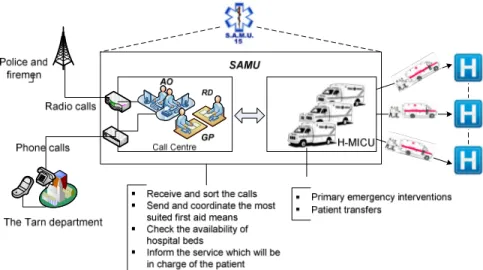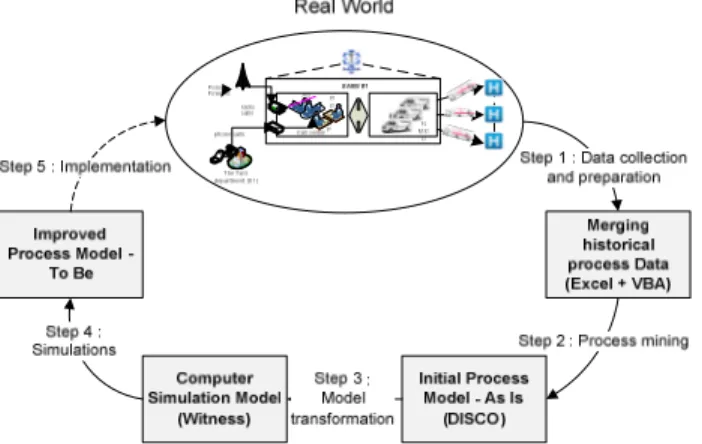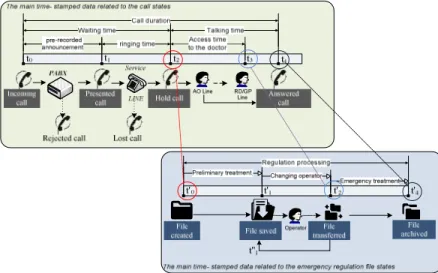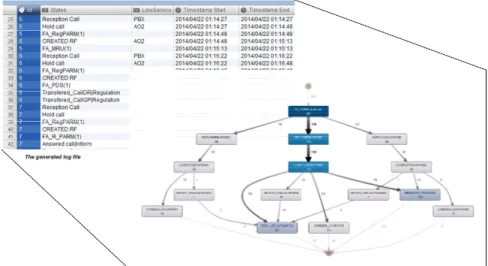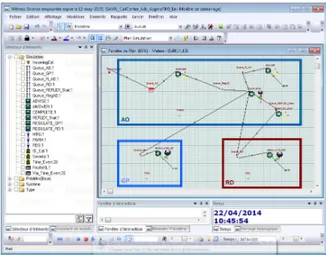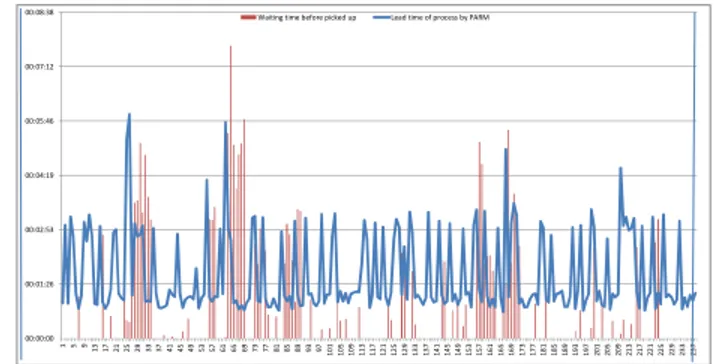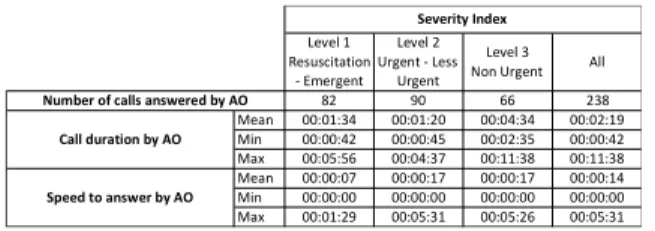HAL Id: hal-01437942
https://hal.inria.fr/hal-01437942
Submitted on 17 Jan 2017
HAL is a multi-disciplinary open access
archive for the deposit and dissemination of
sci-entific research documents, whether they are
pub-lished or not. The documents may come from
teaching and research institutions in France or
abroad, or from public or private research centers.
L’archive ouverte pluridisciplinaire HAL, est
destinée au dépôt et à la diffusion de documents
scientifiques de niveau recherche, publiés ou non,
émanant des établissements d’enseignement et de
recherche français ou étrangers, des laboratoires
publics ou privés.
Distributed under a Creative Commons Attribution| 4.0 International License
Service by Combining Process Mining and Discrete
Event Simulation Approaches
Elyes Lamine, Franck Fontanili, Maria Di Mascolo, Hervé Pingaud
To cite this version:
Elyes Lamine, Franck Fontanili, Maria Di Mascolo, Hervé Pingaud. Improving the Management of
an Emergency Call Service by Combining Process Mining and Discrete Event Simulation Approaches.
16th Working Conference on Virtual Enterprises (PROVE), Oct 2015, Albi, France. pp.535-546,
�10.1007/978-3-319-24141-8_50�. �hal-01437942�
Event Simulation Approaches
Elyes Lamine1,2, Franck Fontanili2, Maria Di Mascolo3, Hervé Pingaud1
1Toulouse University – Centre Universitaire Jean-François Champollion, France
{elyes.lamine, herve.pingaud} @univ-jfc.fr
2 Toulouse University – Industrial Engineering Department, Mines Albi, France – {franck.fontanili, elyes.lamine}@mines-albi.fr
3
University Grenoble Alpes, G-SCOP, F-38000 Grenoble, France CNRS, G-SCOP, F-38000 Grenoble, France
Maria.Di-Mascolo@g-scop.grenoble-inp.fr
Abstract. Each Emergency Medical Assistance Centre in France (SAMU), includes an emergency call service. It provides an adequate and immediate response to medical problems. The processing of the incoming calls can be seen as a collaborative process involving several stakeholders. The control of such a process is crucial. Indeed, the effectiveness of the response to these incoming calls strongly impacts the quality of service of these centres, which is the main information which the government relies for their funding. The aim of this paper is to analyse such a collaborative process, regarding the performance targets requested by the French government. To this end, we suggest applying a new approach, based on the combination of two well-known engineering techniques, in consecutive manner. We will first use process mining techniques to obtain meaningful knowledge about the studied collaborative processes, relying on real data from a French Emergency Medical Assistance Centre. Secondly, we will use a Discrete Event Simulation approach as an effective tool to assess the efficiency of the current management of this emergency call centre and to ask (and answer) some 'what if?' questions to identify possible ways of improving their effectiveness.
Keywords: Emergency Call centre, collaborative Process analysis, Knowledge discovery, Process mining, Discrete-Event Simulation, Key Performance Indicators
1 Introduction
Since 1986 in France, each administrative department has its own Emergency Medical Assistance Centre (named SAMU in French) whose 24-hour service able to provide assistance for all medical emergencies. SAMU works closely with local
public services and emergency teams having skills and facilities suitable to many situations.
Each SAMU has an emergency medical regulation call centre that can be reached by dialling 15 or 112. The origins of phone calls are varied: ordinary people, call centres of firemen, private general practitioners, public or private medical centres. The aim of this centre is to give a suiting answer to the medical problems submitted to it as soon as possible. The action to take in a medical emergency depends on the degree of urgency, ranging from a simple medical advice to the commitment of the Hospital Mobile Intensive Care Units (H-MICU) which are the most potent means of action at the disposal of SAMU call centres.
The processing of the incoming calls may be schematically described as a collaborative process involving several stakeholders, as show in Fig. 1. There are three kind of human resources devoted to a SAMU call centre to regulate the calls: 1) the Medical Regulation Assistant Operator (AO), 2) the Hospital "regulator doctor" a regulator doctor (RD), 3) the general practitioners of the health care permanence (GP). This collaborative process can be done through four major functions: 1) to receive and sort the calls 24 hours a day, 2) to send and coordinate the most suited first aid means as soon as possible, 3) to check the availability of hospital beds to refer the patients to the most appropriate service depending on his/her pathology, 4) to inform the service which will be in charge of the patient for a better welcome.
Fig. 1. Operational organisation of the SAMU 81
According to the statistics announced by the National French SAMU [1], a very large number of calls, which currently varies from tens of thousands to several million, is processed each year and continues to increase from one year to the other, despite constant means.
While these figures are impressive, the processing of the incoming calls has been considered, for too long, of minor importance. The search of better response to the patient and better efficiency in the use of resources induces, in France today, to
consider this process as crucial for the regulation of emergency medicine. The Speed of response between calling 15 and the actual answering of the call has become one of the top priorities of a SAMU call centres [2, 3]. Indeed, the effectiveness of the response to the incoming calls strongly impacts the quality of service of these centres, on which is the main information which the government relies for their funding [4].
Thus, the improvement of the quality of service in these centres has got an
increasing interest in these recent years. It is thereforeimportant to highlight that the
quality of service is tightly related to the means made available to the SAMU and the service organization established.
Hence, our present study is focused on the analysis of the performance of the processing incoming calls of such centres with two major aims: 1. To investigate the management of a SAMU call centre and assess the efficiency of the current management of this emergency call centre regarding to the performance targets requested by the French government; 2. To find out some possible ways of improving the speed and quality of service offered by SAMU .
The remainder of this paper is structured as follows: First, in the next section we are going to give an overview of our proposed approach to analyse and ascertain proposals able to improve the current functioning of emergency call services. This approach is based on the sequential combination of two well-known engineering techniques. In the third section, we will focus our endeavour on the presentation of the two first steps of our proposed approach. These steps lie on the use of process mining techniques to obtain meaningful knowledge about the studied collaborative processes, relying on real data from a French Emergency Medical Assistance Centre.
In Section 4, we willpresent the main results provided by a Discrete Event Simulation
approach as an effective tool to assess the efficiency of the current management of this emergency call centre and discuss some possible ways of improving their
effectiveness. Finally in section 5, we willconclude and present some future works.
2 Proposed Approach for Process Reengineering
The deployment of a process reengineering approach is needed to achieve the two objectives mentioned above. Indeed, the aim of process reengineering approach according to [5] is rethinking and radical redesign of business processes to achieve
dramatic improvements in critical, contemporary measures of performance, such as cost, quality, service and speed.
Roughly speaking, the deployment of process reengineering approach involves three main stages: 1) the discovering stage which aims to reveal how business processes currently operate, 2) the redesigning stage which seeks to find out new ways of organizing tasks, organizing people, able to improve efficiency of these processes; 3) the implementation stage which takes a close interest on how to implement these process changes in an efficient manner.
Traditionally, for the first stage, the discovery of business process models result from a field observation and survey allowing the emergence of knowledge of how the process works which in turn will lead to model the As-Is process in formal process
modelling language. However, this traditional approach is time-consuming, as it implies lengthy discussions with workers, extensive document analysis, careful observation of participants, etc. and also it may not provide an accurate picture of business processes, Indeed there often are discrepancies between the actual business processes and the way they are perceived or described by people [6].
As outlined in several works [6–9], Process Mining techniques appear to be an appropriate tool for going beyond the drawback of this traditional process discovery approach. Indeed, process mining is a promising approach to obtain a better understanding about how business process of an organization are currently being performed and this by analysing the historical process data recorded in the information system of the organization. Consequently, we suggest a new process reengineering approach which consists of a synergy of two well-known engineering techniques, in consecutive manner: process discovery technique with discrete Event Simulation method. In particular, after a period of observation and data gathering, we will use a process mining technique to provide an accurate view on the process of the regulation of incoming calls and model how it is really executed by analysing the historical process data recorded in the information system of the call centre.
Based on the output of the process mining technique enactment, we will use a discrete Event Simulation approach as an effective tool to assess the efficiency of the management of the current process and to ask some 'what if?' questions to identify possible ways of improving their effectiveness.
Discrete events simulation is a data-processing tool widely used in industry and by the researchers to reproduce the dynamic behaviour of a manufacturing system studied [10, 11] in order to subject them to predictive experimentation without risk or disturbance of the real life system. More specifically, our proposed approach consists of the following four successive steps, shown in Fig. 2:
Fig. 2. Proposed system reengineering approach based on the combination of two well-known engineering techniques: Process mining and Simulation.
1. Data collection and preparation step: it is the starting point of any process mining technique. It consists in looking at historical process data and
generating a dataset in the form of so-called event logs that can be used as input for the process mining step.
2. Process mining step: the aim of this step is to discover and construct, from the generate event logs, the process model of the processing of incoming calls of the Medical Assistance Centre. So, the output of this step is the As-is model 3. Model Transformation step: Following an approach grounded in Model-Driven
Engineering (MDE), this step aims at generating a computer simulation model from the As-Is knowledge model. The resulting model will be executed on the selected simulation tool.
4. Simulation step: It seeks to ascertain and to assess a couple of scenario for process improvement regarding to the performance targets requested by the French government. The development of the simulation model of our process
is carried out with the software Witness1.
It is worth noting that this proposed approach is not limited to analyse and to enhance an emergency call centre but could be used for any reengineering process needed since a significant time-stamped and valuable data are tracked and closely related to the process execution.
3 The Discovery of the Incoming Call Regulation Process
3.1 Data Collection and Preparation
The generation of a representative activity log is the starting point for process mining techniques. It is the aim of the data collection and preparation step. It includes 1. Searching and extracting useful data about process execution, 2. Structuring and cleaning these data (correcting typos, outliers, and missing values); 3. Converting these data to the format required by the process mining tool.
For our case study, the data gathering was undertaken in the emergency medical call centre of SAMU 81, located in Albi, France. To identify the relevant data needed to be extracted, our method was based on the analysis of the states throughout an incoming call with this call centre. Indeed, many time-stamped data can be found in the information system of this emergency call centre related to call states updates. The main interesting call states for our study are (see Fig. 3):
• An incoming call state: it is the initial state which corresponds to a call
initiated by an exterior caller to the SAMU ending up at its private automatic branch exchange (PABX). The time of reception of an incoming call is the one of the relevant event tracked by the SAMU IT support system.
• A rejected call state consists of an incoming call that has been automatically
filtered by SAMU PABX. It could be possibly a number phone among the black list of SAMU or rejected automatically beyond a deadline set.
• A presented call state is an incoming call on the verge of being handled by an operator (AO)
• A hold call state consists of state which a call has been handled by an operator
(AO)
• A lost call state consists of state which a presented call is neither held
• An answered call state it is the final state which corresponds to a call picked
up and processed.
Fig. 3. Generate activity log from call and regulate file states
Although these states are interesting to discover the incoming call regulation process, it remains a blur to discover milestones between the moment where the call is picked up and the moment where it is hung up. Indeed, a hold call can generate one or several movements corresponding to periods of communication on distinct phone line services.
To overcome this issue, we have enriched our dataset by other useful time-stamped data related to the emergency regulation file states. In fact, when the AO holds the incoming call, he opens a regulation file (RF) and if necessary a medical regulation file (MRF), localizes the request and saves the phone number, evaluates the gravity of the emergency in differentiating a real emergency from a felt one, transmits the call to the regulator doctors. Then, he has to pass the intervention requests on, either after a practitioner's regulation or directly (Reflex Departure) during very few cases according to the service protocols (sudden death, cardiac arrest, death by hanging…). In the IT support system, there also are many data related to the lifecycle of theses emergency regulation file, as depicted in Fig.3.
Once these data have been collected, we conducted a first cleaning which allowed us to exclude all outgoing calls-related data and to complete some missing information. After we have proceeded to the merger of the two dataset into one log file by linking
together information of both dataset that belong to the same process execution . This linking is based on the identification of the phone number and the date of creation of each regulation file and incoming call and several others data as the line service number or the kind of resource (AO, GP, RD) as show in Fig 3.
3.2 Displaying the Mined Model
The next step was to run the process mining algorithm within Disco tool2, namely the
Christian’s Fuzzy miner, to discover the control flow of the incoming call regulation process. The resulting mined model is shown in Fig. 4. It is based on the sequence and timing of the activities in the generate event log dataset.
We can see that there are 267 cases which represent the total incoming calls covered by the chosen timeframe which corresponds on the most critical day (Sunday). We can easy notice that all these cases start with the activity reception call and are served according to the first-come first-served discipline.
Fig. 4. The resulting mined model of the incoming call regulation process from the generated
log file
The section below presents the statistics deduced from this mined model and in relation to the simulation process model
4 Simulation Model
4.1 “As-Is” Call Centre Simulation Model
In this section, we present the "As-is" simulation model built with the information discovered from the process mining tool. We decided to focus our simulation study on
the (AO) Assistant Operator's activities because the performance of the emergency call centre is mainly dependent on the answer speed of this resource. The call duration of the AO is another KPI we will examine as an outcome of the simulation. The development of the simulation model of our process is carried out with the software package Witness (see a screenshot on Fig. 5).
Witness is a general-purpose discrete-event simulation software widely used to simulate manufacturing processes. Its simulation engine can however also be used to simulate any service or information process. In our study case, there are three modules (AO, GP and RD) corresponding to the three resources of the call centre (Assistant Operator, General Practitioner and Regulator Doctor). As outlined in the mined model, when somebody calls the emergency number, the incoming call is buffered in a queue “Queue_AO”. If the AO is available, he picks up his phone to answer the call. If the AO is busy, then the incoming call is waiting until the end of the process done by the AO. Once a call is held, the AO must open a regulation file and Complete information about the patient. After this stage, regarding to the evaluated severity, either the AO (1) keeps the call (severity index = 3, not urgent call) and only gives some advice to the patient or (2) puts the call in the queue "Queue_GP" (severity index = 2, serious call requiring a Regulation process by a doctor) or (3) activate a Reflex start of an emergency team with a hospital mobile intensive care unit (severity index = 1, life is at risk) if any regulation doctor is not available or transfer the call to the queue "Queue_RD" of the RD.
Fig. 5. Simulation model (Witness software tool)
The speed to answer an incoming call must be as short as possible (less than 30 sec. is the objective for this kind of service [4]), particularly for severity index =1.
The simulation study has been carried on the most critical day (Sunday), as it is the day when the number of incoming calls is the highest. Fig. 6 illustrates the distribution of 267 incoming calls on 48 slots of 30 minutes. As far as the incoming call distribution is concerned, the simulation model is based on statistics from data collected by the SAMU 81.
0 2 4 6 8 10 12 0 :0 0 1 :0 0 2 :0 0 3 :0 0 4 :0 0 5 :0 0 6 :0 0 7 :0 0 8 :0 0 9 :0 0 1 0 :0 0 1 1 :0 0 1 2 :0 0 1 3 :0 0 1 4 :0 0 1 5 :0 0 1 6 :0 0 1 7 :0 0 1 8 :0 0 1 9 :0 0 2 0 :0 0 2 1 :0 0 2 2 :0 0 2 3 :0 0 N u m b e r o f in c o m in g c a lls Hour slots
Fig. 6. Incoming calls profile
As presented in Table 1, the processing times of the different activities follow a uniform distribution and have been established thanks to data collected and the outcomes of the process mining step.
Table 1. Processing times
Res. Activities Process time (sec.) ANSWER and SORT OUT UNIFORM(20,50) COMPLETE regulation file UNIFORM(20,30) ADVISE UNIFORM(100,140) R D REGULATE UNIFORM(300,420) G P REGULATE UNIFORM(300,420) A O
The simulation runs for 24 hours from 00:00 to 24:00. At 00:00, the call centre is
empty. The statistics are recorded between the 26th and the 263th call after a warm up
period. Fig. 7 shows the different values of speed to answer time and processing time (call duration) for all the calls supported by the AO during 24 hours.
00:00:00 00:01:26 00:02:53 00:04:19 00:05:46 00:07:12 00:08:38 1 5913 172125 293337 414549 535761 656973 778185 899397 1 0 1 1 0 5 1 0 9 1 1 3 1 1 7 1 2 1 1 2 5 1 2 9 1 3 3 1 3 7 1 4 1 1 4 5 1 4 9 1 5 3 1 5 7 1 6 1 1 6 5 1 6 9 1 7 3 1 7 7 1 8 1 1 8 5 1 8 9 1 9 3 1 9 7 2 0 1 2 0 5 2 0 9 2 1 3 2 1 7 2 2 1 2 2 5 2 2 9 2 3 3 2 3 7
Waiting time before picked up Lead time of process by PARM
Fig. 7. Speed to answer time (red - thin) and AO's processing time (blue -bold)
Fig. 8 highlights the speed to answer according to severity index (level 1 is for a very serious call, level 2 is for an urgent call and level 3 for non-urgent call). In this "As-is" process, each call is processed by the AO until the transfer or the end of communication, even if another call is in the queue "Queue_AO".
00:00:00 00:01:26 00:02:53 00:04:19 00:05:46 00:07:12 00:08:38 2 5 30 35 40 45 50 55 0 665 70 75 80 85 90 95 1 0 0 1 0 5 1 1 0 1 1 5 1 2 0 1 2 5 1 3 0 1 3 5 1 4 0 1 4 5 1 5 0 1 5 5 1 6 0 1 6 5 1 7 0 1 7 5 1 8 0 1 8 5 1 9 0 1 9 5 2 0 0 2 0 5 2 1 0 2 1 5 2 2 0 2 2 5 2 3 0 2 3 5 2 4 0 2 4 5 2 5 0 2 5 5 2 6 0 Level 1 Level 2 Level 3
Fig. 8. Speed to answer by AO (As-Is)
Table 2 gives the descriptive statistics for each type of calls according to its severity index. We can see that a very serious call (severity index = 1) can wait more than 5 minutes whereas the objective is to pick up a call in less than 30 seconds.
Table 2. Statistics for each severity index of call (As-Is)
Level 1 Resuscitation - Emergent Level 2 Urgent - Less Urgent Level 3
Non Urgent All
82 90 66 238 Mean 00:01:21 00:01:01 00:03:00 00:01:41 Min 00:00:42 00:00:45 00:02:26 00:00:42 Max 00:05:56 00:01:18 00:03:35 00:05:56 Mean 00:00:37 00:00:58 00:00:50 00:00:48 Min 00:00:00 00:00:00 00:00:00 00:00:00 Max 00:05:13 00:05:48 00:07:45 00:07:45 Severity Index
Number of calls answered by AO Call duration by AO Speed to answer by AO
4.2 “To-Be” Call Centre Simulation Model
With the "As-is" rule, all the calls are treated in the same way whatever their severity index. Following this work, we want to assess a "To-be" process with a new rule for the AO: rather than process a call until its transfer, even if a new call arrived in the queue, we propose to put it on hold in order to quickly evaluate the severity index of the new call. If the severity index of the new call is smaller than the current one, the AO process it until its transfer to RD or GP and then pick up the previous call he was processing. 00:00:00 00:00:43 00:01:26 00:02:10 00:02:53 00:03:36 00:04:19 00:05:02 00:05:46 00:06:29 2 5 30 35 40 45 50 55 0 665 70 75 80 85 90 95 1 0 0 1 0 5 1 1 0 1 1 5 1 2 0 1 2 5 1 3 0 1 3 5 1 4 0 1 4 5 1 5 0 1 5 5 1 6 0 1 6 5 1 7 0 1 7 5 1 8 0 1 8 5 1 9 0 1 9 5 2 0 0 2 0 5 2 1 0 2 1 5 2 2 0 2 2 5 2 3 0 2 3 5 2 4 0 2 4 5 2 5 0 2 5 5 2 6 0 Level 1 Level 2 Level 3
Fig. 9 presents the speed to answer with this "To-be" rule evaluated with the simulation and Error! Reference source not found. gives the same statistics as those presented for the "As-is" situation in Table 2. In the "As-is" process, the maximum waiting time of a very urgent call reached more than 5 minutes (00:5:13).
With the proposed rule, the maximum waiting time does not exceed 1 min 29 sec. while the mean value is 7 seconds (37 seconds with the "As-is"). The speed of answer of less urgent calls does not highly increase contrary to not urgent calls.
To summarize, the simulation study shows that applying this new rule could be the first step to improve the performance of this call centre by taking into account an incoming call in the queue.
Table 3: Statistics for each severity index of call (To-Be)
Level 1 Resuscitation - Emergent Level 2 Urgent - Less Urgent Level 3
Non Urgent All
82 90 66 238 Mean 00:01:34 00:01:20 00:04:34 00:02:19 Min 00:00:42 00:00:45 00:02:35 00:00:42 Max 00:05:56 00:04:37 00:11:38 00:11:38 Mean 00:00:07 00:00:17 00:00:17 00:00:14 Min 00:00:00 00:00:00 00:00:00 00:00:00 Max 00:01:29 00:05:31 00:05:26 00:05:31 Severity Index
Number of calls answered by AO Call duration by AO Speed to answer by AO
5 Conclusion and Future Work
In this article, we describe a new approach for reengineering process, based on the combination of process mining and discrete-event simulation techniques in consecutive manner. We suggest to show the interest of the use of this approach to improve the management of an Emergency Call Service. The applying of the process mining technique allowed us to discover the control flow of the incoming call processing and several others useful figures. The most challenging point was the generation of the log file. In addition, the use of Simulation to analyse the "As-is" dynamic behaviour of the process allows us to identify weaknesses, to identify and implement the best KPI's. Moreover, the main reasons to include simulation in our study is to evaluate "To-be" improvements of the current process as optimizing business rules, effective staff deployment, etc.
The future work can be focused on the use of the simulation to optimize the human resources in relation with the call centre activity. The timetables and work organisation could be considered as control variables. Furthermore, we attend to extend our log files by other useful information to cover all the functions of the SAMU.
References
1. Giroud, M.: Samu de France: WEB Site of System of Emergency in France, http://www.samu-de-france.fr/en/System_of_Emergency_in_France_MG_0607.
2. Bieger, A., Borges, G., Kranz, S., McGowan, C., Meehan, K., Mancuso, L.G., Guerlain, S., de Macedo Guimaraes, L.B.: Increasing the efficiency of a Brazilian Emergency response Call Center. Systems and Information Engineering Design Symposium, 2009. SIEDS ’09. pp. 125–130 (2009).
3. Lima, M.A. de Q.V., Maciel, P.R.M., Silva, B., Guimarães, A.P.: Performability evaluation of emergency call center. Perform. Eval. 80, 27–42 (2014).
4. Dreyfus, P.: Activity of the Samu - Centre 15 Definitions and standardization of data, (2009).
5. Hammer, M., Champy, J.: Reengineering the Corporation: A Manifesto for Business Revolution. Harper Business, New York (NY) (1993).
6. Rebuge, Á., Ferreira, D.R.: Business process analysis in healthcare environments: A methodology based on process mining. Inf. Syst. 37, 99–116 (2012).
7. Van der Aalst, W.M.P.: Process Mining. Springer Berlin Heidelberg, Berlin, Heidelberg (2011).
8. Bouarfa, L., Dankelman, J.: Workflow mining and outlier detection from clinical activity logs. J. Biomed. Inform. 45, 1185–1190 (2012).
9. Caron, F., Vanthienen, J., Baesens, B.: A comprehensive investigation of the applicability of process mining techniques for enterprise risk management. Comput. Ind. 64, 464–475 (2013).
10. O’Kane, J.F., Spenceley, J.R., Taylor, R.: Simulation as an essential tool for advanced manufacturing technology problems. J. Mater. Process. Technol. 107, 412–424 (2000). 11. Jacobson, S.H., Hall, S.N., Swisher, J.R.: Discrete-Event Simulation of Health Care
Systems. In: Hall, R.W. (ed.) Patient Flow: Reducing Delay in Healthcare Delivery. pp. 211–252. Springer US (2006).
